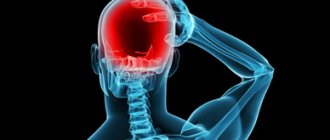Derealization, also called allopsychic depersonalization, is a pathological condition in which the psychosensory perception of the reality of the surrounding world is disrupted.
With this disorder, a person perceives the surrounding reality distortedly; it may seem distant, unreal, and discolored. Reality is perceived as illusory. Familiar surroundings, objects, and phenomena feel alien, unnatural, and modified. Or, on the contrary, the individual experiences deja vu (dejavu - already seen).
A person experiences sensations similar to a dream, like being inside a computer game; the world seems unreal.
Derealization is a neurotic disorder. Often, the patient retains complete control over his actions, demonstrates adequate behavior and is completely sane. The individual is aware of the illogicality and unreality of his condition. Derealization syndrome can manifest itself for a short or long time, it can occur sporadically, or it can be repeated frequently.
The connection between derealization and depersonalization
Derealization often occurs together with personality disorder - depersonalization.
With depersonalization, the individual perceives his body and his own actions as an outside observer who does not have the ability to control. The International Classification of Diseases does not separate these two conditions and labels them as “Depersonalization-Derealization Syndrome” (F 48.1). The term “derealization” is often understood as a group of disorders with similar symptoms, which are expressed in a distorted perception of the surrounding reality.
Complex of provoking reasons
Derealization is considered a fairly common disorder, it is observed in more than 4% of people, and the number of patients is growing all the time. It often acts as a human defense mechanism in stressful situations, during various shocks and experiences. Most often, this perception disorder occurs in individuals of both sexes under the age of 25, that is, during the period of formation and self-determination.
The disorder is most often observed in extroverts who are overly impressionable and emotional. There is a high risk of attacks of disorder in individuals prone to perfectionism and having an inflated level of aspirations.
Among the main reasons causing the development of derealization are:
- Biochemical reasons . The patient’s body produces insufficient amounts of dopamine, serotonin, norepinephrine, which regulate the functioning of the psycho-emotional sphere and are responsible for the feeling of pleasure and positive attitude. The cause may also be a lack of gamma-aminobutyric acid, reduced function of the neural opiate system. Heredity. The tendency to pathological anxiety can be genetically determined, and be a kind of “family” way of reacting to stressful situations.
- Personal and psychological reasons . The development of the disorder can be caused by the presence of such individual human traits as impressionability, suspiciousness, increased demands on oneself, vulnerability, perfectionism, pedantry, and a tendency to fixate on negative situations.
- Somatic causes . The development of derealization can be triggered by the presence of the following diseases in an individual: hypoglycemia (low blood glucose levels); some diseases of internal organs; pathological processes in internal organs; hyperthyroidism (excessive thyroid function); diseases of the respiratory system; pheochromocytoma (a hormonally active tumor, most often located in the adrenal medulla); mitral valve prolapse.
- Social reasons . The disorder can develop as a result of an unfavorable family situation, childhood psychological trauma, a conflict situation in an educational or work community, the death of loved ones, the presence of a protracted or incurable illness, divorce, or lack of emotional support.
- Dependencies . Risk factors for the development of the syndrome are drug and alcohol addiction, smoking, and use of psychoactive substances.
- Lack of a healthy lifestyle . Lack of sleep, poor quality sleep, lack of proper rest, improper work schedule, mental and physical overload are also favorable conditions for the development of the disorder.
Derealization is rarely the only disorder in an individual, and often it accompanies depersonalization, VSD, panic attacks, and schizophrenia.
Treatment
Since conditions such as derealization and depersonalization are not independent diseases, treatment will be aimed at eliminating the underlying disease. This problem requires an integrated approach, which can be implemented by doctors of various specializations, but psychotherapists and psychiatrists play the leading role in correcting the disorder.
Therapy should be carried out in several directions:
- Medicines are actively used in the treatment of derealization and depersonalization. Recommended medications include tranquilizers, antipsychotics and antidepressants. These drugs can reduce the manifestations of anxiety and eliminate depression, against the background of which pathology can develop. In addition, other medications may be recommended. Prescriptions depend on the type of the patient’s underlying disease, his individual characteristics and the severity of the pathology.
- Among psychotherapeutic methods, the most effective are cognitive-behavioral techniques. Good results can be achieved by combining the methods of self-hypnosis, art therapy, music therapy, etc. Auxiliary techniques can improve the patient’s psycho-emotional state.
- Rehabilitation helps to avoid the re-development of derealization. This becomes possible thanks to the normalization of sleep, work and rest patterns, as well as the elimination of stress factors that can provoke a relapse of the disease.
To prevent the need for treatment of derealization from arising at all, you need to pay special attention to strengthening the psyche and nervous system. After all, events leading to the development of stress can happen at any time to any of us. Exercising, walking in the fresh air, eating a healthy diet and maintaining a sleep schedule - all this will help a person cope with negative factors and maintain mental health.
Symptoms and clinic of derealization
With derealization, patients have the feeling that reality, objects, and society are not natural, fantastic, alien, while the patient cannot find an explanation for how this happened.
Reality is perceived as if through a dream, as if through glass, an opaque film, or fog. The surroundings can be perceived as scenery. Everything around seems to have no volume, fuzzy, dim, and without perspective.
During attacks of the disorder, the perception of time is distorted. Some patients have the feeling that the processes around them have slowed down and stopped. Other patients, on the contrary, have a feeling of acceleration of time processes, the rapidity of events. In rare cases, the perception of the past, present and future disappears, and everything is perceived as the present.
The most common symptoms of derealization are visual disturbances. The surroundings may be perceived as monochromatic, gray, and blurry. Everything around may resemble a pencil drawing.
In rare cases, the opposite may happen - everything around seems very bright, like cartoons. Visual distortions also occur in “tunnel” vision, when everything except the object in focus blurs together. Also, the world around can be perceived upside down by 180°, or as a mirror image.
Hearing disorders are expressed in the perception of other people's speech as slow, heightened perception of individual sounds, and ringing in the ears. Sounds may be perceived as distant.
With allopsychic depersonalization, disturbances in tactile perception occur: the patient cannot determine by touch the physical parameters of an object (temperature, material, texture).
The distortion of the perception of space is expressed in the fact that the individual cannot assess the distance: the distant seems close, the close seems distant.
National Institutes of Health Stroke Scale (NIHSS)
National Institutes of Health Stroke Scale/NIH Stroke Scale
Developed by the American National Institutes of Health (National Institutes of Health Stroke Scale - NIH Stroke Scale) T.Brott et al, 1989, J.Biller et al, 1990. Used to objectify the condition of a patient with ischemic stroke upon admission, in the dynamics of the process and outcome of the stroke by the 21st day of hospital stay. The scale contains 15 points that characterize the basic functions most often impaired due to cerebral stroke. Functions are assessed in points. The scale is obviously simple, filling it out requires no more than 5-10 minutes, disciplines the doctor in terms of the need for a comprehensive examination of the neurological status, and allows recording the dynamics of the patient’s condition during the acute period of the disease. The internal consistency and test-retest reliability of the scale has been confirmed by a number of studies (Goldstein JC et al 1989). The absence of changes in the neurological status is provided as 0 points, the death of the patient - 31 points.
| Sign | Determining scale point values |
| Consciousness: level of wakefulness | 0 - Clear 1 - Stupefaction (inhibited, drowsy, but reacts even to a minor stimulus - a command, a question) 2 - Stupor (requires repeated, strong or painful stimulation in order to make a movement or become temporarily available to contact) 3 - Coma ( inaccessible to speech contact, responds to stimulation only with reflex motor or autonomic reactions) |
| Consciousness: answers to questions Ask the patient to name the month of the year and his age | 0 - Correct answers to both questions 1 - Correct answer to one question 2 - Incorrect answers to both questions |
| Consciousness: following instructions (ask the patient to close and open his eyes, clench his fingers into a fist and unclench) | 0 - Executes both commands correctly 1 - Executes one command correctly 2 - Executes both commands incorrectly |
| Eyeball movements (finger tracking) | 0 - Normal 1 - Partial gaze paralysis (but no fixed deviation of the eyeballs) 2 - Fixed deviation of the eyeballs |
| Visual fields (examined using finger movements, which the researcher performs simultaneously on both sides) | 0 - No impairment 1 - Partial hemianopsia 2 - Complete hemianopsia |
| facial muscles | 0 - No 1 - Mild (asymmetry) 2 - Moderately expressed (complete or almost complete paralysis of the lower group of facial muscles) 3 - Complete (lack of movement in the upper and lower groups of facial muscles) |
| Movements in the arm on the paresis side The arm is asked to be held for 10 s in a position of 90° in the shoulder joint if the patient is sitting, and in a flexion position of 45° if the patient is lying | 0 - The hand does not fall 1 - The patient first holds the hand in a given position, then the hand begins to fall 2 - The hand begins to fall immediately, but the patient still somewhat holds it against the force of gravity 3 - The hand immediately falls, the patient is completely unable to overcome the force of gravity 4 — No active movements |
| Movements in the leg on the side of the paresis The patient lying on his back is asked to hold the leg bent at the hip joint, raised at an angle of 30°, for 5 s | 0 - The leg does not fall for 5 seconds 1 - The patient first holds the leg in a given position, then the leg begins to fall 2 - The leg begins to fall immediately, but the patient still holds it somewhat against the force of gravity 3 - The leg falls immediately, the patient is completely unable overcome gravity 4 - No active movements |
| Ataxia in the limbs of the PSP and PCP (ataxia is scored only when it is disproportionate to the degree of paresis; in case of complete paralysis, it is coded with the letter “N”) | 0 - No 1 - Present in either the upper or lower limb 2 - Present in both the upper and lower limb |
| Sensitivity Tested using a pin, only impairments are taken into account | 0 — Normal 1 — Slightly reduced 2 — Significantly reduced |
| Neglect | 0 - Does not ignore 1 - Partially ignores visual, tactile or auditory stimuli 2 - Completely ignores stimuli from more than one range |
| Dysarthria | 0 - Normal articulation 1 - Mild or moderate dysarthria (slurres some words) 2 - Severe dysarthria (pronounces words almost unintelligibly or worse) |
| Aphasia | 0 - No 1 - Mild or moderate (mistakes in the name, paraphasia) 2 - Severe 3 - Total |
Diagnosis and test for the disorder
It is necessary to carry out differential diagnostics to make a diagnosis. This is necessary in order to exclude the presence of more serious psychopathological syndromes. For this, psychotherapists use a survey using the Nuller and Genkina scale.
This derealization test can be taken online and allows you to identify the severity of the disorder, determine whether the patient is aware of the pathology of his perception, and whether he is able to give a critical assessment of his feelings. During the test, the patient is asked questions related to symptoms, and the patient must indicate the extent and frequency of their occurrence. Test results of 30-31 points indicate the presence of the syndrome in the patient.
In addition, the doctor needs to examine the patient, checking his reflexes, skin condition, etc., check for the presence of autonomic disorders, study the medical history of the patient and his family, and prescribe an examination (urine and blood tests, electrocardiogram, electroencephalography, magnetic resonance imaging). It is also necessary to conduct a sensory sensitivity test, which includes checking tactile sensations, reaction to light, visual and auditory perception.
The diagnosis of derealization is made if the patient can critically assess his condition; realizes that the distortion of the surrounding world occurs exclusively in his perception; is in clear consciousness.










